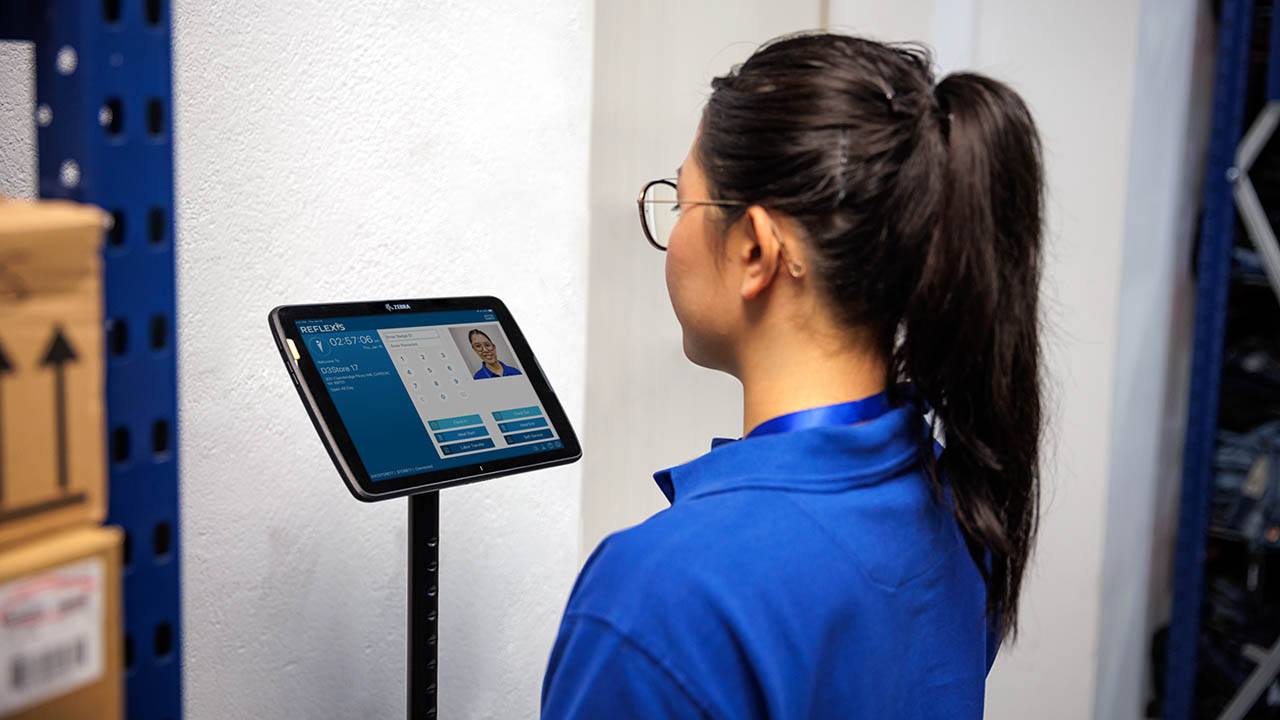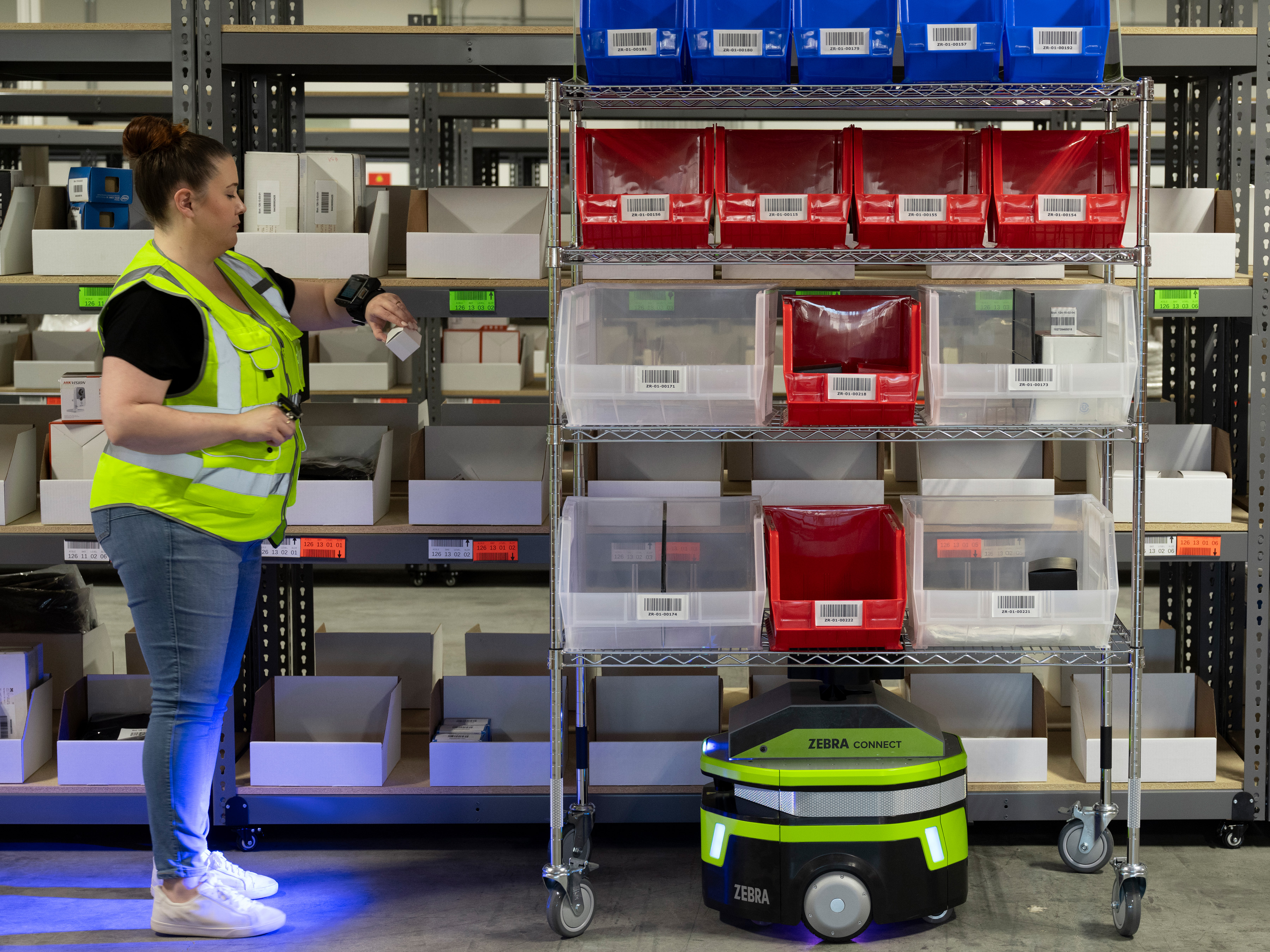Transform retail operations with Zebra’s retail technology solutions, featuring hardware and software for improving inventory management and empowering teams.
Streamline operations with Zebra’s healthcare technology solutions, featuring hardware and software to improve staff collaboration and optimize workflows.
Enhance processes with Zebra’s manufacturing technology solutions, featuring hardware and software for automation, data analysis, and factory connectivity.
Zebra’s transportation and logistics technology solutions feature hardware and software for enhancing route planning, visibility, and automating processes.
Learn how Zebra's public sector technology solutions empower state and local governments to improve efficiency with asset tracking and data capture devices.
Zebra's hospitality technology solutions equip your hotel and restaurant staff to deliver superior customer and guest service through inventory tracking and more.
Zebra's market-leading solutions and products improve customer satisfaction with a lower cost per interaction by keeping service representatives connected with colleagues, customers, management and the tools they use to satisfy customers across the supply chain.
Empower your field workers with purpose-driven mobile technology solutions to help them capture and share critical data in any environment.
Zebra's range of Banking technology solutions enables banks to minimize costs and to increase revenue throughout their branch network. Learn more.
Zebra's range of mobile computers equip your workforce with the devices they need from handhelds and tablets to wearables and vehicle-mounted computers.
Zebra's desktop, mobile, industrial, and portable printers for barcode labels, receipts, RFID tags and cards give you smarter ways to track and manage assets.
Zebra's 1D and 2D corded and cordless barcode scanners anticipate any scanning challenge in a variety of environments, whether retail, healthcare, T&L or manufacturing.
Zebra's extensive range of RAIN RFID readers, antennas, and printers give you consistent and accurate tracking.
Choose Zebra's reliable barcode, RFID and card supplies carefully selected to ensure high performance, print quality, durability and readability.
Zebra's location technologies provide real-time tracking for your organization to better manage and optimize your critical assets and create more efficient workflows.
Zebra's rugged tablets and 2-in-1 laptops are thin and lightweight, yet rugged to work wherever you do on familiar and easy-to-use Windows or Android OS.
With Zebra's family of fixed industrial scanners and machine vision technologies, you can tailor your solutions to your environment and applications.
Zebra’s line of kiosks can meet any self-service or digital signage need, from checking prices and stock on an in-aisle store kiosk to fully-featured kiosks that can be deployed on the wall, counter, desktop or floor in a retail store, hotel, airport check-in gate, physician’s office, local government office and more.
Adapt to market shifts, enhance worker productivity and secure long-term growth with AMRs. Deploy, redeploy and optimize autonomous mobile robots with ease.
Discover Zebra’s range of accessories from chargers, communication cables to cases to help you customize your mobile device for optimal efficiency.
Zebra's environmental sensors monitor temperature-sensitive products, offering data insights on environmental conditions across industry applications.
Enhance frontline operations with Zebra’s AI software solutions, which optimize workflows, streamline processes, and simplify tasks for improved business outcomes.
Zebra Workcloud, enterprise software solutions boost efficiency, cut costs, improve inventory management, simplify communication and optimize resources.
Keep labor costs low, your talent happy and your organization compliant. Create an agile operation that can navigate unexpected schedule changes and customer demand to drive sales, satisfy customers and improve your bottom line.
Drive successful enterprise collaboration with prioritized task notifications and improved communication capabilities for easier team collaboration.
Get full visibility of your inventory and automatically pinpoint leaks across all channels.
Reduce uncertainty when you anticipate market volatility. Predict, plan and stay agile to align inventory with shifting demand.
Drive down costs while driving up employee, security, and network performance with software designed to enhance Zebra's wireless infrastructure and mobile solutions.
Explore Zebra’s printer software to integrate, manage and monitor printers easily, maximizing IT resources and minimizing down time.
Make the most of every stage of your scanning journey from deployment to optimization. Zebra's barcode scanner software lets you keep devices current and adapt them to your business needs for a stronger ROI across the full lifecycle.
RFID development, demonstration and production software and utilities help you build and manage your RFID deployments more efficiently.
RFID development, demonstration and production software and utilities help you build and manage your RFID deployments more efficiently.
Zebra DNA is the industry’s broadest suite of enterprise software that delivers an ideal experience for all during the entire lifetime of every Zebra device.
Advance your digital transformation and execute your strategic plans with the help of the right location and tracking technology.
Boost warehouse and manufacturing operations with Symmetry, an AMR software for fleet management of Autonomous Mobile Robots and streamlined automation workflows.
The Zebra Aurora suite of machine vision software enables users to solve their track-and-trace, vision inspection and industrial automation needs.
Zebra Aurora Focus brings a new level of simplicity to controlling enterprise-wide manufacturing and logistics automation solutions. With this powerful interface, it’s easy to set up, deploy and run Zebra’s Fixed Industrial Scanners and Machine Vision Smart Cameras, eliminating the need for different tools and reducing training and deployment time.
Aurora Imaging Library™, formerly Matrox Imaging Library, machine-vision software development kit (SDK) has a deep collection of tools for image capture, processing, analysis, annotation, display, and archiving. Code-level customization starts here.
Aurora Design Assistant™, formerly Matrox Design Assistant, integrated development environment (IDE) is a flowchart-based platform for building machine vision applications, with templates to speed up development and bring solutions online quicker.
Designed for experienced programmers proficient in vision applications, Aurora Vision Library provides the same sophisticated functionality as our Aurora Vision Studio software but presented in programming language.
Aurora Vision Studio, an image processing software for machine & computer vision engineers, allows quick creation, integration & monitoring of powerful OEM vision applications.
Adding innovative tech is critical to your success, but it can be complex and disruptive. Professional Services help you accelerate adoption, and maximize productivity without affecting your workflows, business processes and finances.
Zebra's Managed Service delivers worry-free device management to ensure ultimate uptime for your Zebra Mobile Computers and Printers via dedicated experts.
Find ways you can contact Zebra Technologies’ Support, including Email and Chat, ask a technical question or initiate a Repair Request.
Zebra's Circular Economy Program helps you manage today’s challenges and plan for tomorrow with smart solutions that are good for your budget and the environment.
The Zebra Knowledge Center provides learning expertise that can be tailored to meet the specific needs of your environment.
Zebra has a wide variety of courses to train you and your staff, ranging from scheduled sessions to remote offerings as well as custom tailored to your specific needs.
Build your reputation with Zebra's certification offerings. Zebra offers a variety of options that can help you progress your career path forward.
Build your reputation with Zebra's certification offerings. Zebra offers a variety of options that can help you progress your career path forward.

How to Assess Schedule Quality in Workforce Management Software (and Why You Should)
Optimizing operations and enhancing customer service can be easy if you’re using the right key performance indicators (KPIs). But how can you be certain you’re using the right KPIs?
Workforce management (WFM) software can play a pivotal role in modern business operations, as a high-quality schedule not only boosts operational efficiency and employee satisfaction but also improves customer service. Of course, you must ensure the technology tool you choose is capable of producing a high-quality schedule if you want a significant return on investment (ROI).
That’s why you need to run some quality checks from time to time. Are the schedules being created proving to be effective? Are they giving you the right staffing levels from both a headcount and skill set perspective based on business demand and objectives?
Not sure? I’m not surprised.
The challenge in determining if a WFM tool is actually helping your business often lies in identifying the right key performance indicators (KPIs) to assess schedule quality. The best way to address this challenge is to align your KPI selection with your business’ overarching goals and leverage the data available within your WFM tools. (Yes, “tools” plural. Not just your scheduler.)
The Importance of KPIs in Schedule Quality Assessments
Selecting the appropriate KPIs to evaluate schedule quality will be a very personal exercise, as you have different business objectives and labor considerations than others. However, I am happy to share some commonly used KPIs by many of Zebra's Workcloud Workforce Optimization customers to get you thinking about what you might want to leverage. These KPIs offer valuable insights and can be used individually or weighted to calculate an overall schedule quality score.
1. Schedule Efficiency
One fundamental KPI in schedule quality assessment is schedule efficiency. It measures how effectively a schedule meets your workforce requirements while minimizing overstaffing and understaffing.
Efficiency is calculated as a function of overs and unders against the required workload. For example, if a system schedules five employees when only three are needed, the shift coverage may seem adequate at 100%. However, two extra staff members are scheduled in this scenario, resulting in a 40% deviation from the optimal staffing level. Therefore, efficiency is just 60% due to overstaffing. The efficiency of a weekly schedule is a factor of all deviations (not just overs, but unders too).
Improvement tip: Aligning employee contracts or availability with your store, bank branch or restaurant demand can significantly enhance scheduling efficiency. For example, some customers are using tools such as Zebra AI Staff Planner (AISP) to help improve staffing forecasts based on comprehensive data and analytics. By relying on data-driven recruitment strategies, this type of AI tool enables you to determine the required roles, the number of employees needed, and the optimal contract times. This approach answers critical labor-related questions, streamlining the scheduling process.
2. Schedule Adherence
Schedule adherence is another pivotal KPI that assesses how closely employees adhere to their scheduled shifts. It is calculated as the percentage of scheduled hours actually worked. Utilizing a timekeeping solution is essential for accurate measurement, though. While this KPI may not seem directly related to schedule quality, it holds significance. Consistently high numbers of timecard exceptions, such as early clock-ins, early clock-outs, and missed breaks, can indicate issues with the inputs used to optimize schedules. Such discrepancies can impact the overall quality of the schedule and lead to increased costs.
Example: In a company with 10,000 full-time employees working five shifts a week, if 20% of employees clock in one minute early and finish one minute late, the additional weekly payments can total $5,000/£4,106/4,743 euros (assuming a $15/£12/14 euro hourly wage rate), adding up to $260,000/£213,543/246,662 euros annually (excluding the soft costs of time spent on clearing timecard exceptions).
3. Schedule Coverage
It's crucial to schedule the appropriate number of employees for specific time slots to match the forecasted labor requirements, so an effective schedule involves creating shifts that align with the generated labor forecast/demand. Schedule coverage guarantees sufficient employees are scheduled to meet the projected demand.
For instance, if a system schedules three or four employees for a shift when only three are required, the shift coverage in both scenarios would still be considered 100%. Many of the workforce scheduling tools our customers use rely on the 'Minimum Coverage' functionality to guarantee 100% schedule coverage for critical store tasks like store opening/closing, always having one first aider available, etc.
4. Employee Satisfaction
To ensure schedule quality, you must close the loop with employees to make sure they agree it’s a ‘good schedule.’ Measuring their satisfaction is crucial, and the best way to do that is by using feedback and surveys based on rules rather than preferences (to avoid subjectivity). Refining business rules based on common feedback themes can lead to better schedule adherence and overall employee satisfaction. It's essential to strike a balance between individual preferences and organizational rules.
For example, someone may not like working two late nights in a week. But is it within the defined rules? Someone may prefer to start their shift at a different time than 08:45 am. However, is it within their defined availability and company rules?
5. Schedule Cost
Analyzing the cost-effectiveness of schedules is vital for successful workforce management. However, simply relying on an average hourly wage rate and scheduled hours to calculate the cost of a particular schedule is insufficient. There is functionality available now to help you consider individual employee costs, overtime payments, evening premiums, and other factors when calculating schedule costs. This provides a more accurate picture of the financial implications of scheduling decisions.
For example, the cost of an 8-hour scheduled shift on a weekend calculated purely on the wage rate ($15/£12/14 euros per hour) and scheduled hours will be $120/£98/114 euros. However, if the overtime rules (time and a half on weekends) are also considered for the cost calculation, the cost will be $180/£148/170 euros. So, using premiums factors provides a more accurate picture of the financial implications of scheduling decisions.
6. Schedule Compliance
Schedule compliance involves assessing the extent to which schedules adhere to both labor laws and business-defined rules. Ensuring compliance with labor laws, such as a maximum of five consecutive shifts, is crucial to avoid legal issues. Similarly, adhering to business-defined rules, such as limiting the number of Saturdays an employee can work in a given timeframe, is essential to maintain operational consistency and employee fairness and increase employee satisfaction.
7. Shift Swap/Give Away Shifts
Tracking the frequency of employee requests for shift swaps or shift giveaways can reveal potential scheduling issues or employee dissatisfaction. A high rate of such requests may warrant a closer look at the scheduling process and its impact on employee well-being.
8. Certifications (Training and Skills) Match
It is essential for efficient operations to assess whether employees with specific skills are scheduled for tasks that match their capabilities. Any mismatch in this regard should be factored into the overall schedule quality metric calculation.
In Conclusion
The selection of KPIs should always align with your organization's unique objectives. Regularly analyzing these KPIs empowers you to fine-tune your scheduling processes and enhance overall workforce management. By focusing on schedule quality, you can better optimize operations, improve customer service, improve employee satisfaction and maximize the ROI from your WFM solutions.
If you need help figuring out which KPIs will be best for you to use, you can always contact a Zebra WFM specialist here. You can also learn more about the WFM solutions available on the market today to help automate or assist with scheduling and schedule quality assessments here.

Ashish Sawhney
Ashish Sawhney is currently the Director of Global Professional Services at Zebra, where he is responsible for leading the global team of Functional Consultants, Implementation Specialists, Project Managers, Program Managers and AAR Cognos Developers. He has more than 12 years of experience within the retail and software industries, and his team has successfully implemented software for many of the world's biggest retailers.
Previously, he served as a Technical Consultant at JDA, as well as a Functional Consultant and Head of Delivery at Reflexis Systems and Zebra Technologies, where he managed the technical solution design, functional solution design and overall implementation delivery. Ash holds a Master of Business Administration (MBA) in IT from Coventry University and Bachelor's in Computer Application (BCA) from Jammu University.
Zebra Developer Blog
Zebra Developer Blog
Are you a Zebra Developer? Find more technical discussions on our Developer Portal blog.
Zebra Story Hub
Zebra Story Hub
Looking for more expert insights? Visit the Zebra Story Hub for more interviews, news, and industry trend analysis.
Search the Blog
Search the Blog
Use the below link to search all of our blog posts.
Most Recent
Legal Terms of Use Privacy Policy Supply Chain Transparency
ZEBRA and the stylized Zebra head are trademarks of Zebra Technologies Corp., registered in many jurisdictions worldwide. All other trademarks are the property of their respective owners. ©2025 Zebra Technologies Corp. and/or its affiliates.






